Top 10 Street Combinations of Wing Chun Kung Fuby William Cheung (extracted from Karate/Kung Fu Illustrated, Dec 1997) It’s renowned as the art that was designed for street fights. Proponents claim that because it was created by a woman, its techniques and combinations are so efficient that a small person can easily defeat a larger and stronger attacker. To top it all off, it was the art that Bruce Lee cut his teeth on, the one whose principles he drew on to form the basis of jeet kune do. The art, of course, is wing chun kung fu. This article, appropriately enough, is about the top 10 street combinations as rated by William Cheung, one of the most respected wing chun masters in the world. – Ed
Strike to the Throat This technique uses a pak sao (slapping block) to the elbow and bil gee (finger jab) to the throat. When you do the pak sao, you control the blind side of your opponent. His right arm is restrained, and his other arm can’t reach you. Basically he’s neutralized. Because the bil gee technique is so narrow, it can penetrate nearly any barrier created by your opponent’s arm and body. It hits a major pressure point on the throat. That can cause suffocation and affect the central energy flow of the body. The opponent will be weakened and possibly disabled. Smash to the Eyes You do a larp Sao (grabbing-hand block) to intercept your opponent’s incoming punch. That controls his arm. Then you grab his wrist to keep control of it. Pull him across and slightly forward to break his balance. As in the first technique, situate yourself on his blind side so you don’t have to deal with his free arm. The best way to execute the wang tseung (sidepalm strike) is to go high to the eye level. Then, even if he positions his shoulder to protect his jaw, you don’t have to worry about it. If you actually strike him in the eye, it will tear up, and he will be temporarily blinded. There is a chance the palm strike could break his nose, too. It’s a good initial strike because you can easily inflict a controlled amount of damage and pave the way for a follow-up technique.
Your opponent attacks with a straight punch to your head. You do a double-arm grab on the punching arm, and that controls his balance. Then you strike to the sixth point of his spleen meridian on his shin. That point is very important because three meridians cross there: the liver, spleen and kidney meridians. The instep of your foot strikes his shin. If you have shoes on, it works much better. The strike will produce a lot of pain and paralyze the inside of his leg. It can also damage the organs because the energy flow in the meridians directs the blood flow. The technique can also act as a sweep or throw, or it can be used to break his balance so your follow-up technique is more likely to succeed.
This technique is used to counter a strike. You start with a double larp sao, which controls your opponent’s balance. Then you stomp diagonally into his knee. This blow can actually dislocate his knee, but if you don’t kick quite hard enough, it can put him off-balance. It’s fairly easy to damage the ligaments on the side of the knee. And it’s very painful because the ligaments are not very elastic. Needless to say, the technique works better if you’re wearing shoes.
Your opponent throws a punch, and you deflect it with a bil sao (thrusting-hand block) to the elbow. At the same time you use your toes to kick the floating ribs or a pressure point (liver, spleen) on the side of his torso. Without shoes, you can kick with the ball of your foot. The technique is good for the street because it can be commenced from a neutral side stance. And it’s over quickly because the kick is one continuous motion. To generate maximum power while kicking with your front leg, you have to learn how to thrust it. You should hold it out there so the power can be transferred into the target. Jab to the Eyes This was one of Bruce Lee’s favorite techniques. Your opponent throws a round punch, and you counter with a larp sao to his elbow. This stops the punch immediately. From there, do a spear hand, or bil gee, to the eye. Because the eyes are what is known as a “soft-tissue target,” you only have to touch them to do a lot of damage. It’s enough to hit one eye, because they both will start watering. And when your opponent can’t see, he can’t retaliate. The technique is very practical because you have an extra two-and-a-half inches of reach when you extend your fingers. And because it’s hard for anyone to see something moving toward his eyes, it’s hard to stop the strike. Kick to the Knee The technique is used to block a round kick and deliver a counterstrike to the knee. The kick is stopped by the bon Sao (wing-arm block), a very powerful block that will stop anything that comes in front of you. Your opponent will definitely feel the effects of the block on his leg. Then you strike with a low side kick to the knee, which can easily injure the joint. It can also put him off-balance so you can follow with another technique. The side kick should hit with the heel; that’s where you need to concentrate your whole force. Blow to the Chin When your opponent strikes with his arm, you deflect it with a pak sao to his elbow. At the same time, you right hand moves upward along his arm to his jaw. The technique is very effective because the counterattack is instantaneous. A strike to the side of his jaw can knock him out. A strike underneath it can make his head snap back, and this can damage the nerves inside the vertebrae.
Striking with the elbow is more powerful than punching because the elbow is closer to the body. When you throw an elbow strike, you use a lot of body twist for power. It’s very hard for your opponent to block because the distance traveled is small and the time it takes to strike is very short. This makes it hard to detect. With the elbow, you can strike a hard or soft area. There’s a major pressure point on the stem of the skull that can be attacked. On the side of the head you can aim for the jaw, and on the front, there’s the cheekbone or nose. Because the elbow is very pointy, it’s as easy to open a cut on your opponent as it is to break a bone. To avoid injury to yourself, strike with the outside of your elbow. The inside is not as strong. That’s why you have to roll the arm and come down to your target.
This technique can easily break your opponent’s leg. You use a double pak sao to control his kicking leg. Since your palms are probably the toughest part of your body, you can use them to stop his leg momentarily and control it. Then you steady it and lift your knee sharply to strike the bone about halfway between the ankle and knee. If you are unsure whether your opponent’s kick will come in high or low, you should pick up your leg anyway. When used in conjunction with your arms and palms, it becomes a multipurpose block. Even if you do not succeed in breaking his leg, you will stop his kick. |
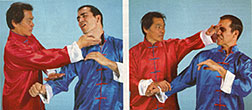
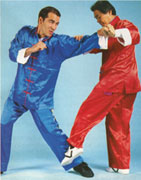 Sweep to the Leg
Sweep to the Leg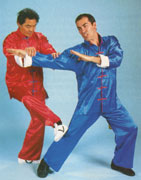 Stomp to the Knee
Stomp to the Knee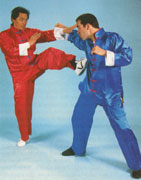 Kick to the Ribs
Kick to the Ribs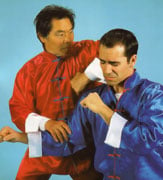 Smack to the Skull
Smack to the Skull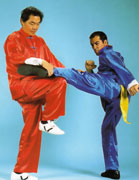 Knee to the Shin
Knee to the Shin